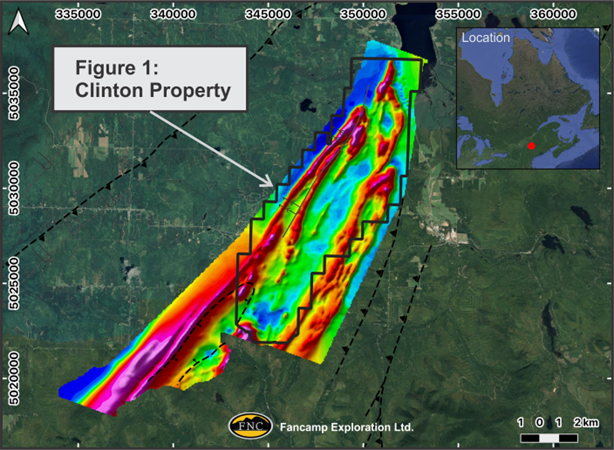Reviewed by Alex SmithAug 18 2022
Fancamp Exploration Ltd. has released the final assay results from its 2022 winter drilling program at its Clinton project situated in the Eastern Townships of Québec, Canada. This location is one of the top jurisdictions internationally in terms of attraction of exploration investments.
 Clinton Property Map. Image credit: Fancamp Exploration Ltd.
Clinton Property Map. Image credit: Fancamp Exploration Ltd.
As reported earlier, Fancamp drilled 1,294 m in 6 holes from February–March 2022 in the northern section of the property to assess huge sulfide lens A — which is one of five massive sulfide lenses on the property. The program efficiently prolonged lens A mineralization, while Cu and Ag grades and mineralized widths were constant with historical intercepts of lens A.
The research also proposes that mineralized lenses A and B might be contiguous. To follow up on those outstanding results, Fancamp — along with TMC Geophysics — will be performing a “Downhole” Pulse EM survey.
The survey hopes to find prospective zones of electrically conductive massive sulfide mineralization in the A/B lens area. Also, the survey will allow Fancamp to better characterize the deposit, thereby minimizing the total exploration cost.
Highlights
- Hole CLDD-22-01: 3.0 m @ 0.72% Cu, 2.87 g/t Ag and 0.02 g/t Au
Outlook
After a 3D modeling review, Fancamp performed a 1,294 m, 6-hole drill program to assess a VTEM plate anomaly located at around 100 m NE of a copper-bearing mineralized lens and to potentially enlarge the lens along strike.
It was possible for Fancamp to establish the prospective connectivity of the A and B lenses and thereby extend the strike length of these two lenses by around 100 m. The drill campaign shows that A and B — the two lenses — can possibly be regarded as a contiguous mineralized zone and coalesce at depth, potentially forming one lens. Those outcomes further indicate a favorable drilling horizon to expand A and B lenses more to the SW.
The mineralization is characteristic of a Volcanogenic Massive Sulfide (VMS) type deposit and takes place at the point of contact between a thick sedimentary sequence and a felsic volcanic unit. An exhalative horizon, comprising finely laminated iron-rich mudstone, with a jasperoid type bed at times, could be traced across the complete strike length of the mineralized horizon.
Being a seamless geophysically and geologically identified marker, the unit will aid in uncovering the mineralized extent of the lens. Fancamp will be updating its geological model and getting ready for a new drilling program directed at increasing the Clinton copper mineralization.
The assay results proved that the winter drill program has been a complete success in confirming the Clinton project is host to significant sulfide copper mineralization, in the shadow of a past-producing mine, which now extends along strike with the potential merging of two copper-bearing mineralized lenses.
François Auclair, Vice President Exploration, Fancamp Exploration Limited
François Auclair adds, “Most encouraging is the fact that the A-B lens remains open to the north and at depth with a plunge to the SW, with extension of the strike length for both lenses by 100 m, where we find hole results that return grades and widths concurrent with historical intercepts. These results suggest there is ample room for additional expansion and growth of the Clinton geological model and drilling strategy.”
About the Clinton Project
The Clinton Project is underlain by a folded and faulted bimodal volcanic sequence, which is home to a series of Cu – Zn precious metals volcanogenic massive sulfide mineralization lenses that extend over a 5 km NE horizon.
Located around 20 km SW of the town of Megantic, the project is located immediately north of the Maine border. It comprises around 20 km of favorable stratigraphy of the Clinton River volcano-sedimentary Belt, which confirms that the Clinton project is host to considerable sulfide copper mineralization — in the shadow of a past producing mine, extending across strike.
From the beginning of exploration during the early 20th century, the property has served as the location for multiple exploration programs. Approximately 62,354 m of drilling along 297 holes was done since 1953.
Confined within five small sulfide lenses — A, C, E, F, and O — comprising 1.52 Mt at 2.02% Cu and 1.54% Zn [MRNFQ Fiche de Gite 21E07-0007], a non-compliant 43-101 historical resource is hosted by the project area.A qualified person has not done enough work to classify the historical estimate as a current mineral resource. The historical estimate is not treated as current mineral resources by the Company.